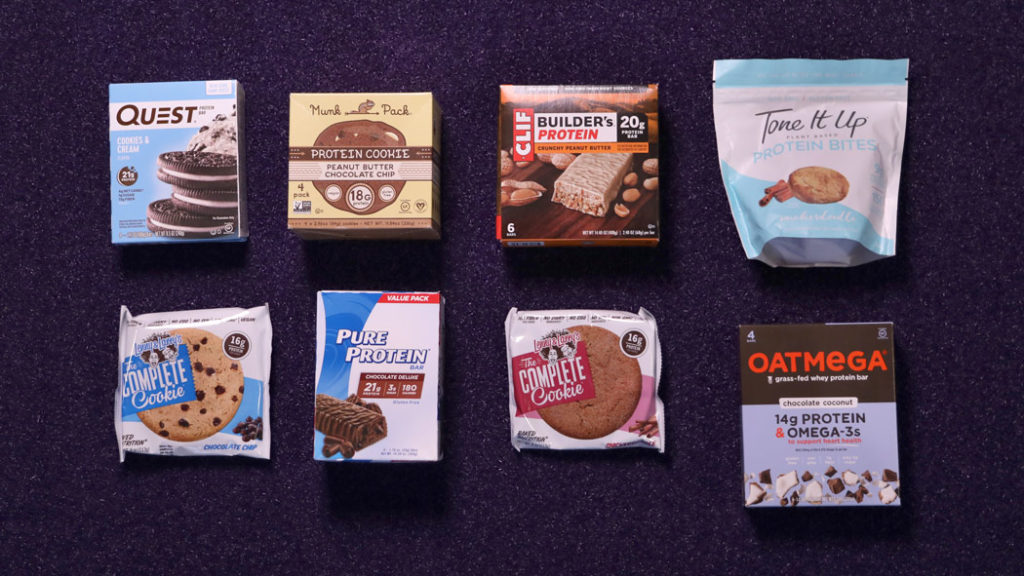If there’s one thing we know to be true, it’s that all protein bars are not created equal. When they’re good—they’re oh-so-tasty, but when they’re bad—they’re terrible. In addition to being hit or miss, protein bars are sought after in a pinch, which is why it’s important to know which bars you should add to your cart before your blood sugar hits an all-time low.
Whether you reach for a protein bar before your workout or like to keep them in your work bag for days when you’ve forgotten lunch, you’ll need to be prepared at the store (or for your web browser, if you prefer to order in bulk from Amazon). There are plenty of factors to consider when choosing a high protein bar, such as the protein blend, grams of sugar, grams of fiber and of course, all the different flavors. Protein bar brands are chock-full of delicious-sounding flavors, with labels like birthday cake, chocolate peanut butter, snickerdoodle and chocolate fudge brownie, but it’s the quality of the protein bar, rather than the flavor, that can really make a difference. From delightful to mealy and everything in between, our editors took the first bite so you don’t have to. We’ve tried plenty of bad protein bars in our day, and we want to save you a little trouble and a lot of chewing. Whether you’re looking for a healthy snack or a meal replacement, we hope that our research helps you find the best protein bar for you. We chose to rate our bars by texture and taste, as calorie needs, protein, fat and sugar content will all vary from person to person. You know how to choose the nutrition label that’s best for you; we’re here to make sure you don’t end up with a bar that crumbles in your hand! Our protein bar taste test can help take the guesswork out of your protein bar selection in hopes that you’ll avoid spit-takes and money down the drain.
Factors to Consider When Choosing a Protein Bar
With so many different nutrition bars to choose from, it’s hard to know which high protein bar is right for you. In addition to the different flavors, like chocolate chip cookie dough or chocolate peanut butter, you’ll want to consider factors like added sugar, protein blend, grams of fiber and fat and of course, great taste.
How much protein is enough protein? Most bars contain anywhere from 12-20g of protein. People looking to build muscle mass probably want a high protein bar, while people who just need an afternoon snack probably don’t need to worry about the exact amount.
Of course, while the primary goal of protein bars is to get more protein in your diet – you didn’t need a coach to tell you that! – there are other factors that are important as well. If you have food sensitivities, you might want to look for a bar that’s gluten-free, like a LUNA Bar. If you’re sensitive to milk protein, you may prefer soy protein. And speaking of protein types, if you follow a vegetarian or vegan diet, you probably want a protein bar that contains all nine essential amino acids. Soy protein is the only vegan protein that contains all nine essential amino acids, but if you don’t like soy protein, you can get all nine by mixing plant proteins with other proteins, like adding sunflower seed butter to a smoothie with pea protein, or sprinkling plant-based protein over cashew yogurt.
We’re here to help advise on great taste and texture, but understanding the nutrition label and ingredients list can help you pick the best protein bar for you. Let’s dive into some common ingredients found in protein products.
Common Ingredients in Protein Bars
Protein bars can be packed with ingredients, and while the labels might sound scary, we promise they’re not all as complicated as they seem. If you prefer whole food, low-sugar nutrition bars made with natural flavors, it’s especially important to know how to read common terms in the labels before you buy a product. Some ingredients, like whey protein concentrate, are more natural than they sound. Others, like high fructose corn syrup, definitely don’t fall under the “natural ingredients” umbrella, and have no place in a healthy protein bar! Rather than staring at your web browser for hours or squinting at a product label, let us help break it down for you.
Let’s start with whey protein concentrate and whey protein isolate. Whey protein is derived from milk, so it contains all nine essential amino acids. The difference is that whey protein isolate is more concentrated than whey protein concentrate. Whey protein isolate is more processed, so it contains fewer grams of fat and carbs, and more protein per serving. For example, a 100-calorie serving of whey protein isolate contains 23g protein, 1g carbs and 0g fat. The same amount of whey protein concentrate contains 18g protein, 3.5g carbs and 1.5g fat. Both whey protein concentrate and whey protein isolate are great choices with plenty of protein, but if you want to exclusively focus on protein without adding extra carbs and fat to your diet, whey protein isolate is probably the right choice. However, note that it’s generally more expensive than whey protein concentrate.
Other popular sources of protein are egg whites, soy crisps and peanut flour. Egg whites are a great source of protein for those that prefer familiar whole foods and natural ingredients. RxBar, known for its short ingredient list, has made them a popular source of protein in protein bars. Soy crisps are another great source of protein, as they’re made from soy flour, and similar to puffed rice. LUNA bars are a good example of a bar that uses soy crisps for texture. As for peanut flour, it’s exactly what you were probably thinking it is – flour made from peanuts! The peanuts are often partially or fully defatted before being turned into flour, which means peanut flour is high protein, low-fat and gluten-free. Add some cocoa powder and bring on the chocolate peanut butter bars, right?
Because soy is such a great protein source, you may have seen soy lecithin on a nutrition label and assumed it was there to provide protein. Soy lecithin is actually a thickening agent, just like tapioca starch. If you see one of these ingredients, they’re in your bar to help hold everything together. Speaking of unfamiliar ingredients, what about calcium carbonate? Don’t worry so much about the carbonate part – calcium carbonate is just a calcium supplement, so you can keep your muscles and bones strong!
One thing that many people like to watch out for, in addition to natural ingredients, is added sugar. We have good news: nutrition labels are now broken up into “sugars” and “added sugars” to help you keep an eye on how many grams of sugar you’re eating! What’s the difference? Think of it this way. A glass of dairy milk contains several grams of natural sugar, whereas a glass of chocolate dairy milk contains natural sugars and added sugars, to get that yummy chocolate flavor. A general rule of thumb if you’re looking to improve your diet is to watch out for added sugars. You might also see something called sugar alcohols on your nutrition label. Sugar alcohols have fewer calories than sugar, so they can be a good choice for people on a low-sugar diet. However, despite being labeled as low-sugar, bars with sugar alcohols can trick your brain’s sweet tooth into wanting more real grams of sugar, so it’s best to keep an eye out for them. While most protein bars contain several grams of sugar, natural flavors and sugars from fruit are probably the best choice.
Our Taste Test Lineup
Pure Protein Bar – Chocolate Deluxe
Oatmega – Chocolate Coconut
Tone It Up Plant-Based Protein Bites – Snickerdoodle
Clif Builder’s Protein – Crunchy Peanut Butter
The Complete Cookie – Snickerdoodle
Quest – Cookies & Cream
Munk Pack Protein Cookie – Peanut Butter Chocolate Chip
Pure Protein Bar
Taste: 4/5
Texture: 5/5
Calories: 180
Protein: 21g protein
Fat: 4.5g fat
Carbs: 17g carbs
Sugar: 3g sugar
Fiber: 2g fiber
If you are a lover of fudge, you’re going to want to keep a box of these protein bars stashed away, especially if you’re gluten-free. Fudgy and decadent despite containing just 4.5g fat, this bar was surprisingly delightful without feeling too thick or overindulgent. Unlike some protein bars, there wasn’t a heavy protein powder aftertaste—which is no small feat for a protein bar with over 20g of protein. This bar is also low in dietary fiber for easy digestion, with just two grams of fiber. We scored these bars at a 4/5 for taste only because the chocolate flavor, while tasty, didn’t have as much depth as gusto as you’d hope for given the rich and chewy texture. We think these are a great option to keep in your desk drawer, or whenever you need to satisfy a chocolate craving.
Oatmega
Taste: 4/5
Texture: 4/5
Calories: 200
Protein: 14g protein
Fat: 7g fat
Carbs: 22g carbs
Sugar: 5g sugar
Fiber: 7g fiber
Traditional protein bar, this is not. But that’s not a bad thing! Imagine if a granola bar and a protein bar made a delicious protein bar baby—you’re looking at an Oatmega protein bar. Oatmega prides themselves on their whole food ingredients like sea salt and whey protein sourced from grass-fed cows in New Zealand, and you can taste why. The protein flavor is faint, and when it does hit—it’s not overwhelming with chemical notes in the way many classical protein powders are. While we’d love to give it five stars all around, the granola-esque texture is slightly gritty and neither the coconut nor the chocolate flavors stand out like you’d expect. While the texture and flavor might not be perfect, Oatmega makes up for that with their partnership with No Kid Hungry in working to end childhood hunger, so you can feel good while you’re enjoying one of their bars.
Tone It Up Plant-Based Protein Bites
Taste: 3/5
Texture: 3/5
Calories: 150
Protein: 9g protein
Fat: 5g fat
Carbs: 16g carbs
Sugar: 6g sugar
Fiber: 4g fiber
In a word, underwhelming. These protein bites aren’t necessarily bad, but they’re certainly not certifiably good either. Their texture is a forgettable blend of dry and crumbly and the promise of snickerdoodle flavor falls short. These also come in chocolate peanut butter, which we wish we’d tried. It’s not all bad though! While their flavor isn’t strong, neither is the protein powder aftertaste, and they’re a nice low-fat and low-calorie alternative to heavier protein bars. But if you’re looking for a protein-packed snack, don’t grab for these with only nine grams of protein per serving. We’d consider these more of a regular snack to keep you satiated in between meals, as they probably aren’t the solution for someone who’s looking to bulk up.
Clif Builder’s Protein
Taste: 5/5
Texture: 5/5
Calories: 270
Protein: 20g protein
Fat: 11g fat
Carbs: 29g carbs
Sugar: 22g sugar
Fiber: 2g fiber
Peanut butter enthusiasts, we’ve found the protein bar for you. This delicious CLIF bar wavers on the cusp of candy bar territory with its hearty peanut butter center layered in a creamy coating that was neither too thin or too thick. The flavor was outstanding, leaving no artificial aftertaste or an overly processed protein bite. Like most CLIF bars, we’d recommend saving this bar for when you need some serious refueling because at 270 calories and 20g of protein, this isn’t for the casual snacker. It also swings high on sugar with 22 grams, the highest by far in our lot, which is probably why we almost confused it for a candy bar. However, it’s surprisingly low in fat for a peanut butter bar. All that aside, if taste and sustenance are your highest priorities, look no further than the Clif Builder’s Protein. You can order them by the 12-pack from Amazon, and trust us, you’ll want at least that many!
The Complete Cookie
Taste: 4/5
Texture: 5/5
Calories: 460
Protein: 16g protein
Fat: 17g fat
Carbs: 56g carbs
Sugar: 26g sugar
Fiber: 10g fiber
Can a cookie make for a good protein bar alternative? Turns out the answer is yes! If you’re expecting a traditional cookie, let us stop you right there. These aren’t your mama’s chocolate chip cookies—but they’re a close relative. They have a surprisingly enjoyable bite and texture with the snickerdoodle cookie reminiscent of a cozy fall-flavored treat. The cookie is rounded out with a warm dusting of cinnamon sugar that gives the cookies a “homemade” nod. The flavor is done well, albeit faint—which is why we’ve given the Complete Cookie four stars for taste. Note that this cookie contains wheat flour, so it isn’t gluten-free. The labeled serving size is actually only half a cookie, as the full cookie is pretty high in calories for a snack. However, if you’re running out the door, it would make a great meal replacement. If you were ever the little kid that wanted to eat cookies for breakfast, this is your chance!
Quest
Taste: 1/5
Texture: 2/5
Calories: 200
Protein: 21g protein
Fat: 8g fat
Carbs: 21g carbs
Sugar: 1g sugar
Fiber: 15g fiber
The moment you unwrap a Quest bar, you’re immediately hit with an unnatural smell that can only serve as a flavor foreshadow of what’s to come. Upon taking a bite, the bar does itself no favors with its chalky texture, high fiber content (15 grams of fiber is a lot for a 200 calorie bar!) and chemical, protein powder taste. While most protein bars attempt to keep sugar counts low, the Quest protein bar does so unapologetically with a very artificially sweetened flavor. Other flavors, like chocolate chip cookie dough, may taste more authentic, but the Cookies & Cream variety left little to be desired. Despite its over 20g of protein, we recommend skipping this bar, altogether. There are plenty of other Quest flavors that might be worth trying, but sadly, we were disappointed by this one.
Munk Pack Protein Cookie
Taste: 3.5/5
Texture: 5/5
Calories: 320
Protein: 16g protein
Fat: 15g fat
Carbs: 34g carbs
Sugar: 16g sugar
Fiber: 5g fiber
This is a chocolate peanut butter cookie. If Munk Pack wants to tell us it’s a protein cookie, that’s fine, but we are here to tell you this is a cookie. Soft-baked and loaded with chocolate chips and chopped peanuts, we were shocked at how well this protein snack resembled a typical cookie. We also loved that we recognized just about everything on the ingredient list. But despite the homemade texture, it wasn’t entirely a home run. The protein powder notes are pronounced and while it’s full of yummy additions like sea salt, it still lacks flavor. It’s also a heavy snack at 320 calories, but with 16 grams of protein—it can be a great option for a quick pick-me-up when you don’t have time to sit down for a meal.
The Winner
Overall, the Clif Protein Builder’s bar far-exceeded our expectations and hit all the right notes with the Pure Protein bar coming in close at number two. If you see one you like, you can buy all of the above products on Amazon. Hopefully you really like them, as most of the Amazon options come in bulk!



